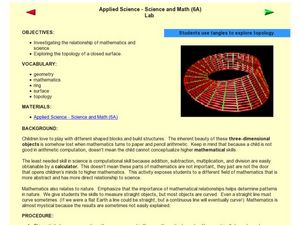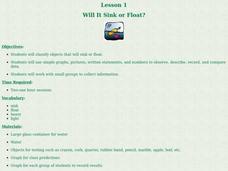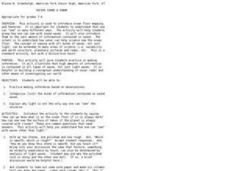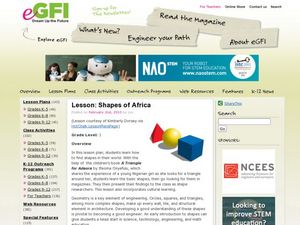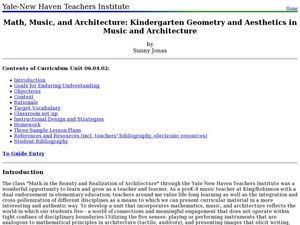Curated OER
Comparing Matter
Students use Internet to research and discover states of matter and explain how molecules are arranged in each state, complete Comparing Matter Work Sheet, and identify objects around classroom that fit three states of matter definitions.
Curated OER
Applied Science-Science and Math Lab
Students explore magnification. In this scientific observation skills lesson, students observe sea life items and draw pictures of what they observe. Students predict which lens will have the strongest magnification when given three...
Curated OER
What's in the Box
Second graders verbalize, write, and illustrate descriptive vocabulary words and/or descriptive phrases while attempting to guess an unseen object, which has been hidden in a box by teacher.
Curated OER
Terrific Tessellations
Students explore tessellations that are found in nature and everyday objects. They observe the works of M.C. Escher. Students create their own tessellations using pencil and paper.
Curated OER
What's The Matter?
Fourth graders accurately describe various states of matter, Through experimentation, they change a variable to create a new state of matter. Students record their observations about the way matter is changed and the changes that occur...
Curated OER
Applied Science - Science and Math Pre Lab
Students explore human senses. In this applied Science lesson, students utilize their senses to distinguish various objects. Students explain their descriptions.
Curated OER
Touch and Feel Box
Students investigate their sense of touch to help become more descriptive with their observations. In this sensory lesson, students reach inside a box to feel an object then guess what it is. Students then use both senses of...
Curated OER
Will It Sink or Float?
Students perform experiments to see if items will sink or float. In this sink or float lesson, students work in groups to make predictions, and record the results. After the experiments are complete students make a book of the results.
Curated OER
Seeing Sound & Sonar
Learners make inferences based on different sounds that they hear. In this inferences lesson plan, students will hear sounds of different objects and describe the sounds based on what they hear. They will answer various questions about...
Curated OER
Acceleration 2
In this acceleration worksheet, students experiment with varying amounts of mass to observe the effects on the force needed to move an object. Students apply Newton's Second Law of Motion to describe the relationship between mass and...
Curated OER
What's It Made Of? What's It Used For?
For this passive present simple verb worksheet, students in groups pick a card and practice describing the object for their group to guess what they are talking about. Students generate how big it is, what it's used for and/or what it's...
Curated OER
Kindergarten Kids- Exploring Illustrations
In this interactive illustration analysis worksheet, students view illustrations of Winnie the Pooh and friends and complete a 16 questions true or false exercise.
Curated OER
Astronomy with a Stick
Students describe the movement of the Earth as it relates to the sun and
formulate a hypothesis for the movement and the changing length of the shadow. They express the relationship between the sun and the Earth and how that causes the...
Curated OER
Sorting and Using Materials
Students explore materials and their properties. In this matter lesson, students identify objects and describe their properties. Students test and sort materials using an interactive whiteboard, followed by a group discussion of what was...
Curated OER
Shapes of Africa
First graders learn the names of geometric shapes and about African cultures. In this geometry and culture lesson, 1st graders describe real world objects and learn to name them with geometric terms such as square, circle, and triangle....
Curated OER
Genre Lesson: Science Fiction
Sixth graders explore the components of science fiction in a science and literacy lesson. As they define and record definitions of the term on the board, learners identify a text as science fiction using the terms they have...
Curated OER
Math, Music and Architecture: Kindergarten Geometry and Aesthetics in Music and Architecture
Students identify and name different geometrical shapes. In this math lesson, students distinguish odd from even numbers. They describe the properties of 2 and 3 dimensional objects.
Pennsylvania Department of Education
A Geometric Scavenger Hunt
Fifth graders connect their knowledge of polygons and polyhedrons. In this geometric shapes instructional activity, 5th graders identify and classify two- and three-dimensional objects. Students construct a polyhedron out of polygons and...
Curated OER
Circles to Spheres
Students investigate circles and spheres. In this space shapes lesson, students compare and contrast two-dimensional and three-dimensional shapes. Students investigate the relationship between plane and space shapes.
Curated OER
Jazzing Up Grammar
Students explore various tenses to use proper grammar. They practice tenses using random objects to describe events. They create timelines to examine different tenses. They role-play situations to practice the correct structure of grammar.
Curated OER
Color Lifting
Students brainstorm and describe why far-away landscape features look less clear than nearby objects. They become aware of and recognize the effects of atmospheric perspective in realistic paintings and then create a realistic landscape...
Curated OER
Describing Words Lesson (Lesson 2)
First graders create a computer slide show. They select pictures from the gallery, write descriptive words or phrases about the pictures, and develop a three slide presentation.
Curated OER
Learning How To Include Proportional Figures and Objects in Landscape Drawings
Fourth graders are shown a slideshow of paintings showing landscapes. They create their own landscape painting using proportional figures.
Curated OER
Revolution Synectics Lesson Plan
Seventh graders discuss and define the word revolution. In this analogy and revolution lesson, 7th graders brainstorm revolution and create a list of objects that are able to revolve. Students then create an analogy using revolution....

